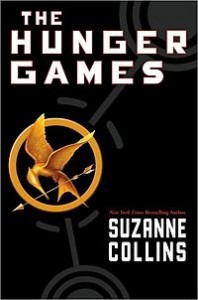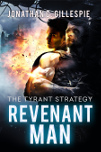Review: The Hunger Games, by Suzanne Collins
November 9, 2012 in General Topics
 If you subscribe to some of the sexier theories in the realm of quantum mechanics, then somewhere, on another Earth, a man named Scott Corbin released a dystopian fiction novel called The Starvation Sports, featuring a plucky young hunter named Pita Melan, and his erstwhile fellow competitor, Chive Evergreen.
If you subscribe to some of the sexier theories in the realm of quantum mechanics, then somewhere, on another Earth, a man named Scott Corbin released a dystopian fiction novel called The Starvation Sports, featuring a plucky young hunter named Pita Melan, and his erstwhile fellow competitor, Chive Evergreen.
And on that Earth, in the United States of Vespuci, a teen girl named Joanna Giles is sitting at her computer somewhere in Cornwallis State, writing out a review on her blog. She’s somewhat befuddled by the story Corbin has told. She enjoyed it, but not as much as she might have. Because in this stream, Corbin’s novel is targeted to adults, it’s written in the third person, and it’s bleak. I mean, Stephen King’s The Long Walk kind of bleak. Every last death in the book is portrayed, graphically at times. This is especially true for the epic showdown between two young men who stay “in-camera” for several pages apart from our protagonists, towards the end of the novel, while Pita and Chive sit in a cave eating roots and rabbits.
Joanna is writing about how she didn’t sign up, so much, to read about combat, intrique and bloodshed. That stuff’s OK, she argues, but The Starvation Games is about Pita’s struggle to define his place in a savage world. Oh, and Joanna needed more romance. A lot more romance. What was up, she types, with all the extended cat-and-mouse scenes away from the two main characters?
Joanna, honey, someone left your book in my quantum stream. You read the book perfect for me; I read the one perfect for you.
The Hunger Games is an intimidating book to review. Its fan base is passionate and devoted. The numbers that swim around this thing almost defy comprehension. Here’s some of the juicier ones:
- More than 26 million copies in print, across all three books in the larger Hunger Games trilogy.
- More than a million ebooks sold.
- 105,041 reviews (as I type this) on Goodreads.
I don’t have to tell you the plot of this book. Your friends already have.
I can tell you that, being an author, I picked up multiple occurences of “it is as if”, said-bookisms, simple but at times repetitive scenes, and supporting character development I wish had been flashed out better.
(None of that matters).
I can tell you the problem with writing a dystopian novel for a young audience, with this subject matter, is it makes cutting gory details very necessary. But the effect of doing that, and choosing first-person perspective will frustrate some adult readers.
(Totally irrelevant to its typical reader).
The reason this novel has sold so well becomes apparent in its perfect placement of thematic material to an obvious target audience. Let’s start with the main character. You can practically hear author Suzanne Collins checking off the boxes to make this thing a commercial juggernaut:
Katniss is 16. Check. She’s a girl. Check. She has an incompetent parent (a phenomenon I’m sure is a tough sell to teen readers). Check. She keeps the family afloat through her wise-beyond-years intelligence and keen understanding of how Panem and the Seam (her home) really work. Check. Oh, she loves her dad, but he was killed years ago. Check. She has to protect her little sister. Check. Protecting her sister will mean taking her place in a bloodsport to the death, thrusting her from one dreamy hunting companion to the company of a boy that once saved her life. Oh, and he’s a dreamboat, too. BLANK CHECK!!!
Of the action in the woods, Collins faced a challenge she met, but not completely satisfactorily. All this effort is spent convincing the reader that Katniss Everdeen is hell on wheels when she has a bow and arrows. But Collins must have realized her own setup would make for a rather bored Capitol, and a perturbed young reader. “Katniss shows up, snipes everyone within twenty minutes” is one dull book. So Collins gets out of this plot trap through a number of plot twists, some of which are effective, and others not so much.
The woods do provide the book’s best scene–the tragic death of a sympathetic character, whose loss is effective and only damaged by the author’s needless invoking of Katniss’ sister. That scene almost had me in tears.
But man, do we spend a lot of time hunting, foraging, taking medicine, cooking and cuddling, and missing what’s going on elsewhere. Again, I’m conscious of the fact that’s what the target audience wants, so I’m not admonishing that–just saying, for an adult male? It’s not working.
(Blah, blah, blah).
I admire this book, and I deeply appreciate Suzanne Collins.
What? Wait. Didn’t I just list about three dozen points of contention? Read on.
While I did find myself waiting for some scenes to end, I never once hated cracking this novel open. I was interested in seeing how the events would play out. I found some of the creative world building very welcome–particularly the “muttations” (with the exception of the ones at the book’s climax). I want a Mockingjay. Badly.
Sure, Suzanne populates her pages with tropes ranging from the familiar to the derivative. So what? Most great fiction borrows elements and inspiration from prior sources. There’s very much a group-think phenomenon at work, too. It’s not hard to understand why the post-apocalyptic and dystopian genres are so popular these days; I myself regularly write about a fractured Earth in my own books. Going deeper, it’s easy to see why The Hunger Games might appeal to understandably-disenfranchised millennials. (How much debt is Jennifer taking on to go to college? Where’s the job she was supposed to have when she graduated? Oh, and did we mention one of her friends just came back from Afghanistan without a leg?)
Where The Hunger Games earns its retail price, for the adult reader, is really in the social commentary. This book’s beginning and ending sequences struck me much harder than all the action in the woods. Having recently watched Sophie Scholl: The Final Days, I was struck by how often The Hunger Games kept eliciting the phenomenon that same film (and true story) invited: What would we do, in the main character’s shoes? To further the comparison, some of the characters in the Capitol resemble the police chief who originally arrested Sophie Scholl. They’ve bought the Capitol’s\Third Reich’s rhetoric and propaganda. They truly believe all the Jews have migrated east. It’s shocking, stark, and too typical of the human nature for us to dismiss it.
I suspect Collins’ nods to history were deliberate, such as her insertion of an antagonist named Cato, but her contemporary comparisons are what really unnerve the reader (in a good way). Here is a Capitol enraptured by the spectacle of watching youth tear each other to pieces. They even vary the Games’ configuration every few years for extra appeal. Of course the similarities with modern reality TV are obvious, but that doesn’t mean they don’t work. Collins hauls out all the ugly elements of our increasingly sadistic and base media tastes, then dials them up to 11. The most effective and haunting scene is the three-hour recap the Capitol makes for the end of each show, apparently played to the kind of upbeat music that every production company trots out for their reality show season finales. You know, after they’ve lovingly encouraged–and filmed–every bit of conflict.
Furthering that point, if one considers themselves so lofty and removed from the Capitol and its citizens, then they need to consider something else. There’s a chance the device you’re reading this on was produced by our own outlying District: China. Yes, China, where tech companies thinks it’s terrific, because they can rouse their workers out of dormitories in the dead of night, give them a cracker and some water, and put them on the assembly line. And how much did money was paid to that worker that made the shirt on your back? Am I hitting too close to home? Or are we hitting too close to Panem?
Finally, as I explained to authors troubled by the Twilight Saga, Collins is bringing new readers into the fold. We need that. Fiction needs that. The readers need that, too–because books are transformative and revealing, and critical of their parent cultures in a way that no other medium has ever been. We need people reading. Especially young people.
So don’t fear the reaping, baby.
3/5 stars. (For young audiences: 4/5 stars).
For more reviews of film, books, and other media, click here.
Enjoyed The Hunger Games? Check out my own take on a dystopian, nigh-apocalyptic future with The Tyrant Strategy: Revenant Man.
Goodreads Book Giveaway
The Tyrant Strategy
by Jonathan C. Gillespie
Giveaway ends December 15, 2012.
See the giveaway details
at Goodreads.


Recent Discussion